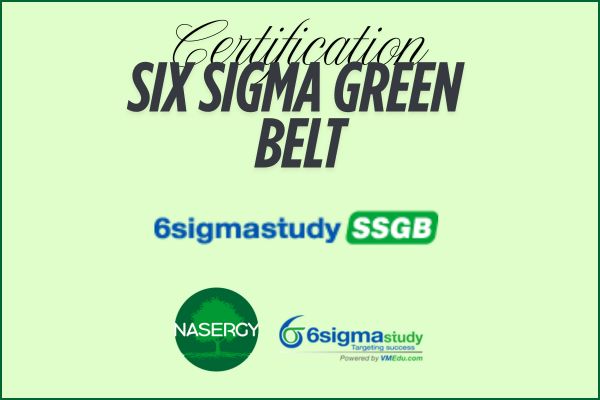
Six Sigma Green Belt Certification Exam
Overview
- Six Sigma Green Belt (SSGB™) course focuses on providing students with an understanding of the various Six Sigma tools and techniques. These tools and techniques are useful in improving the production process and help to minimize defects in the end product. This course lays greater emphasis on the practical implementation of these tool and techniques in the organization.
Prerequisite Education
- Preferably Six Sigma Yellow Belt (But not mandatory)
Target Audience
- Employees and organizations requiring a standardized approach to problem solving for the purpose of continuous improvement in Quality Management.
Cost of Exam
Maintaing Certification
- Take SSGB™ Recertification exam every 3 years or earn any 6sigmastudy™ Certification.
Exam Format
- Multiple Choice
- 90 questions per exam
- One mark awarded for every right answer
- No negative marks for wrong answers
- Duration of 120 minutes
- Online proctored exam
- Current pass rate: 98%
Audience Profile
- This course is highly recommended for employees and organizations requiring a standardized approach to problem solving for the purpose of continuous improvement in Quality Management.
Prerequisites
- Preferably Six Sigma Yellow Belt (SSYB™) certified, but not mandatory.
How to Apply
1- Register and pay for the Six Sigma Green Belt (SSGB™) online course.
2- Get an automated email with the login credentials.
3- Use the login credentials to login and access the course. The online course includes:
a. Videos of important concepts
b. Study Guides
c. Glossary of important terms
d. Chapter Test Questions
4- You can Nasergy Six Sigma Green Belt Course that will simplify the course and provide 2 mock exams similar to the final SSBB exam to ensure passing the exam from first time.
5- Schedule and take the exam.
a. Schedule the 120-minute proctored exam.
b. 6sigmastudy™ verifies the application and confirms the exam date and time.
c. Take the online proctored exam.
6- Upon successful completion of the exam, get an online certificate.
a. Your name will be added to the 6sigmastudy™ Certification Registry.
b. If you are unable to pass the exam, you can schedule the exam again and take a maximum of two Exam Retakes for Free
SSGB Certification Course Topics
1. Introduction to Six Sigma
1.1. History of Quality (Deming, Juran, JIT, Ishikawa, Taguchi, etc.)
1.2. Evolution of Six Sigma
1.3. Defining Six Sigma – philosophy and objectives
1.4. Overview of Six Sigma DMAIC process
2. Stakeholders & Setting up a Six Sigma Project
2.1. Identifying and Documenting stakeholder requirements
2.1.1. Identifying stakeholders and customers
2.1.2. Data collection and analysis
2.1.3. Determining critical requirements
2.2. Project Selection Criteria
2.2.1. Identifying performance metrics
2.2.2. Using Financial criteria to evaluate project benefits
2.2.3. Maximizing project benefits for the organization
2.3. Project Planning
2.3.1. Creating Project Charter
2.3.2. Charter Negotiation
2.4. Managing Team Dynamics
2.4.1. Initiating teams
2.4.2. Stages of team evolution
2.4.3. Maslow’s hierarchy of needs
2.4.4. Motivation Techniques
2.4.5. Conflict Resolution Techniques
2.4.6. Management / Leadership styles
2.4.7. Roles played by people in a project
2.5. Important project management & planning tools
3. Six Sigma Methodology – Define
3.1. Inputs –
3.1.1. Need for six sigma project,
3.1.2. Executive management sponsorship,
3.1.3. Core team identified
3.2. Tools
3.2.1. Organization hierarchy
3.2.2. High level process maps
3.2.3. High level Pareto charts
3.2.4. Idea generation and categorization tools
3.3. 3. Outputs
3.3.1. Project charter
3.3.2. Established metrics
3.3.3. Problem statement
3.3.4. Roles & responsibilities
4. Six Sigma Methodology – Measure
4.1. Objectives of Measure Phase
4.2. Inputs
4.2.1. The outputs of the Define phase
4.3. Tools
4.3.1. Data collection tools and techniques
4.3.2. Measurement scales
4.3.3. Validation techniques (Gauge R & R)
4.3.4. Statistical distributions
4.3.5. Data mining
4.3.6. Run chartsg. Process map
4.3.7. Stakeholder tools
4.3.8. Process costs
4.4. Outputs
4.4.1. Well defined processes
4.4.2. Baseline process capability
4.4.3. Process parameters affecting CTQs
4.4.4. Cost of poor quality (COPQ)
4.4.5. Measurement system
5. Six Sigma Methodology – Analyze
5.1. Objectives of Analyze Phase
5.2. Inputs
5.2.1. Outputs of the Measure phase
5.3. Tools
5.3.1. Ishikawa diagram
5.3.2. Failure mode and effects analysis
5.3.3. Hypothesis testing
5.3.4. Process capability study
5.4. Outputs
5.4.1. Important causes of defects
5.4.2. Special and common causes of variation
5.4.3. DPMO and sigma level
6. Six Sigma Methodology – Improve
6.1. Objectives of Improve Phase
6.2. Inputs
6.2.1. Outputs of the Analyze phase
6.3. Tools
6.3.1. Returns on investment
6.3.2. Solution design matrix
6.3.3. Design of experiment
6.3.4. Taguchi robustness concepts
6.3.5. Response surface methodology
6.3.6. Project planning and management tools
6.3.7. Prototypes
6.4. Outputs
6.4.1. Cost / benefit for different solution
6.4.2. Selection of solutions for implementation
6.4.3. Implementation plan
7. Six Sigma Methodology – Control
7.1. Objectives of Control Phase
7.2. Inputs
7.2.1. Outputs of the Improve phase
7.3. Tools
7.3.1. Control plan
7.3.2. Statistical process control
7.3.3. Lean enterprise
7.3.4. 5S
7.3.5. Kaizen
7.3.6. Kanban
7.3.7. Total productive maintenance
7.3.8. Measurement system reanalysis
7.4. Outputs
7.4.1. Implemented solutions
7.4.2. Revised measurement system
7.4.3. Control plan for sustaining benefitsd. Improves process capability
7.4.4. Lessons learned
8. Case Study
8.1. 1. Case Study Part 1
8.2. 2. Case Study Part 2
8.3. 3. Case Study Part 3